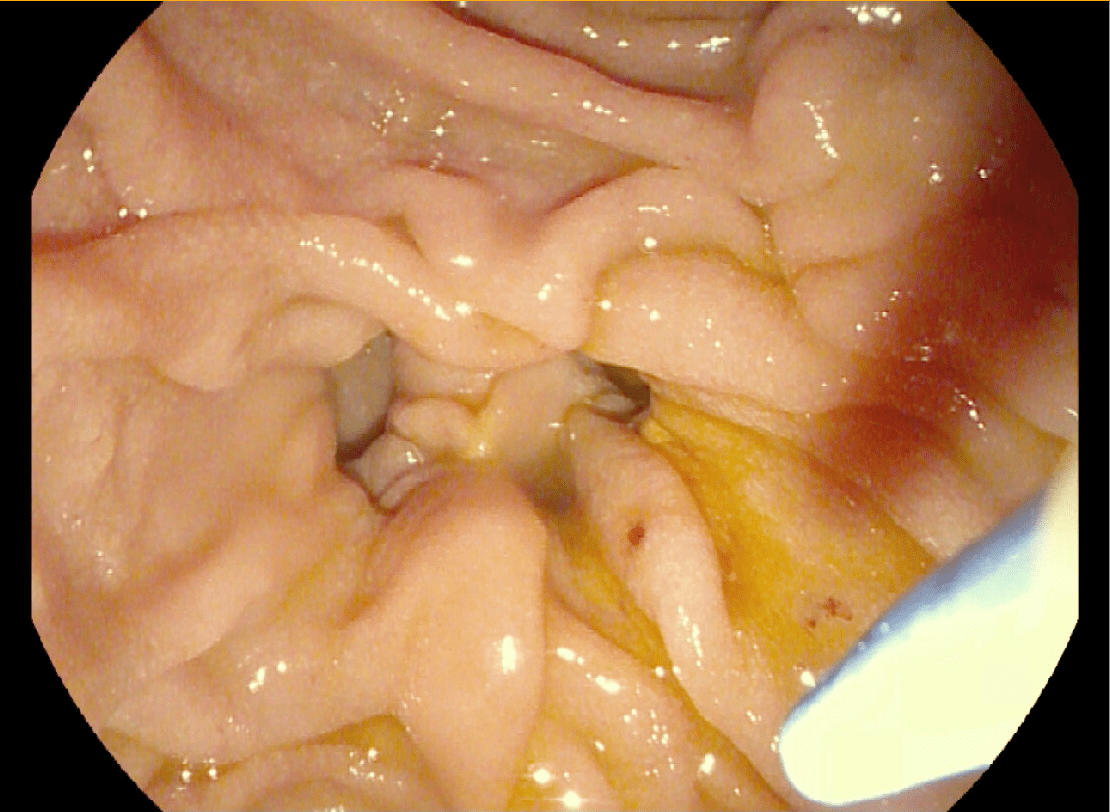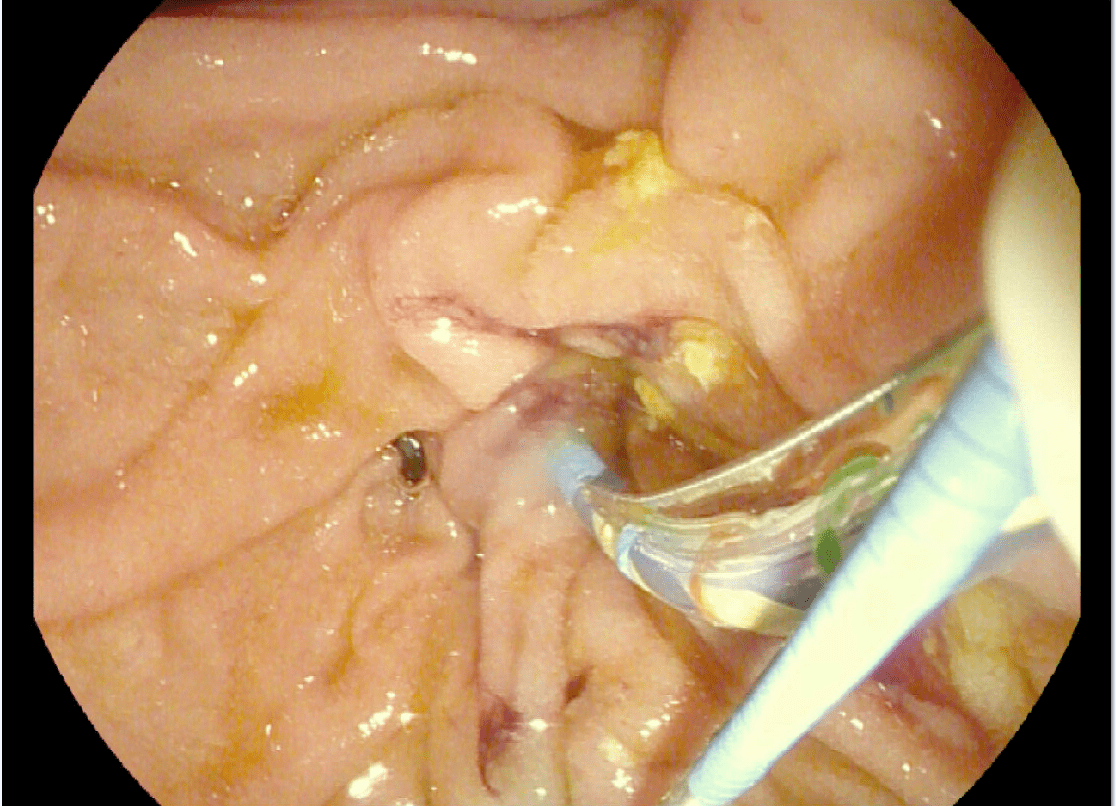Monday Poster Session
Category: Interventional Endoscopy
P3608 - Use of SpyBite Forceps to Facilitate Ampullary Identification in a Patient with a Large Periampullary Diverticulum: A Novel Approach During Difficult Biliary Cannulation
Monday, October 27, 2025
10:30 AM - 4:00 PM PDT
Location: Exhibit Hall

Sufiyan Kamal, MD
University of Texas Health East Texas Physicians
Tyler, TX
Presenting Author(s)
Sufiyan Kamal, MD, Muhammad Majeed, MD
University of Texas Health East Texas Physicians, Tyler, TX
Introduction: Cannulation of the common bile duct during endoscopic retrograde cholangiopancreatography (ERCP) is often challenging in patients with complex anatomy, such as periampullary diverticula, which can obscure visualization of the ampulla and hinder access. Alternative strategies are required in such cases to prevent procedural failure and the need for further interventions. This case highlights a novel application of SpyBite biopsy forceps—typically used for tissue sampling during cholangioscopy—as a mechanical tool to facilitate ampullary identification and successful biliary cannulation.
Case Description/
Methods: A 68-year-old male patient presented with symptomatic choledocholithiasis following an unsuccessful ERCP attempt at an outside facility. On repeat ERCP, a large periampullary diverticulum was noted, obscuring the major papilla. Traditional visualization techniques failed to locate the ampulla. SpyBite forcep (1.2mm) was introduced through the working channel of the duodenoscope to retract mucosal folds within the diverticulum, thereby exposing the concealed ampulla. A 3.9 Fr Jagtome preloaded with a 0.025-inch guidewire was introduced the same scope to achieve successful biliary cannulation without difficulty. A limited cholangiogram confirmed ductal access. Subsequent biliary sphincterotomy and occlusion cholangiography revealed an 8 mm pigmented stone, which was extracted using multiple balloon sweeps. No biliary stent was required. The procedure was well tolerated, and the patient was discharged without complications.
Discussion: This case demonstrates the use of SpyBite forceps as an adjunctive for ampullary identification in the setting of a periampullary diverticulum. In difficult biliary cannulation cases, these adaptations of existing tools may improve success rates and reduce the need for repeat ERCPs and more invasive procedures.

Figure: ERCP image showing a periampullary diverticulum adjacent to the major duodenal papilla.

Figure: SpyBite forceps introduced via the duodenoscope to retract mucosal folds within the diverticulum, facilitating exposure of the obscured ampulla.
Disclosures:
Sufiyan Kamal indicated no relevant financial relationships.
Muhammad Majeed indicated no relevant financial relationships.
Sufiyan Kamal, MD, Muhammad Majeed, MD. P3608 - Use of SpyBite Forceps to Facilitate Ampullary Identification in a Patient with a Large Periampullary Diverticulum: A Novel Approach During Difficult Biliary Cannulation, ACG 2025 Annual Scientific Meeting Abstracts. Phoenix, AZ: American College of Gastroenterology.
University of Texas Health East Texas Physicians, Tyler, TX
Introduction: Cannulation of the common bile duct during endoscopic retrograde cholangiopancreatography (ERCP) is often challenging in patients with complex anatomy, such as periampullary diverticula, which can obscure visualization of the ampulla and hinder access. Alternative strategies are required in such cases to prevent procedural failure and the need for further interventions. This case highlights a novel application of SpyBite biopsy forceps—typically used for tissue sampling during cholangioscopy—as a mechanical tool to facilitate ampullary identification and successful biliary cannulation.
Case Description/
Methods: A 68-year-old male patient presented with symptomatic choledocholithiasis following an unsuccessful ERCP attempt at an outside facility. On repeat ERCP, a large periampullary diverticulum was noted, obscuring the major papilla. Traditional visualization techniques failed to locate the ampulla. SpyBite forcep (1.2mm) was introduced through the working channel of the duodenoscope to retract mucosal folds within the diverticulum, thereby exposing the concealed ampulla. A 3.9 Fr Jagtome preloaded with a 0.025-inch guidewire was introduced the same scope to achieve successful biliary cannulation without difficulty. A limited cholangiogram confirmed ductal access. Subsequent biliary sphincterotomy and occlusion cholangiography revealed an 8 mm pigmented stone, which was extracted using multiple balloon sweeps. No biliary stent was required. The procedure was well tolerated, and the patient was discharged without complications.
Discussion: This case demonstrates the use of SpyBite forceps as an adjunctive for ampullary identification in the setting of a periampullary diverticulum. In difficult biliary cannulation cases, these adaptations of existing tools may improve success rates and reduce the need for repeat ERCPs and more invasive procedures.

Figure: ERCP image showing a periampullary diverticulum adjacent to the major duodenal papilla.

Figure: SpyBite forceps introduced via the duodenoscope to retract mucosal folds within the diverticulum, facilitating exposure of the obscured ampulla.
Disclosures:
Sufiyan Kamal indicated no relevant financial relationships.
Muhammad Majeed indicated no relevant financial relationships.
Sufiyan Kamal, MD, Muhammad Majeed, MD. P3608 - Use of SpyBite Forceps to Facilitate Ampullary Identification in a Patient with a Large Periampullary Diverticulum: A Novel Approach During Difficult Biliary Cannulation, ACG 2025 Annual Scientific Meeting Abstracts. Phoenix, AZ: American College of Gastroenterology.
